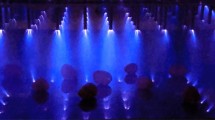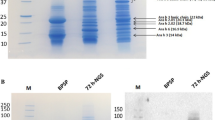Abstract
Pulsed light (PL), a novel food processing and preservation technology, has been shown in literature to reduce allergen levels on peanut, soybean, almond and shrimp protein extracts. This study investigated how PL affected the immunoreactivity of whole peanut kernels at two sample-to-lamp distances (7 and 10 cm) and a PL frequency of 3 pulses/s. A combination of different illumination durations and distances were tested to explore the effective conditions for PL roasting of whole peanuts. After the PL treatments, crude protein of the whole peanuts was extracted and compared to that of the raw peanuts (control) in vitro for allergen reactivity using sodium dodecyl sulfate-polyacrylamide gel electrophoresis (SDS-PAGE), Western blot, dot blot, and enzyme-linked immunosorbent assay (ELISA) with pooled plasma of allergenic patients. The SDS-PAGE, Western blot, dot blot results all showed that PL was capable of mitigating all major allergens of whole peanut kernels to an undetectable level. Indirect ELISA results showed 80 % signal reduction for the PL-treated peanut as compared to raw peanut. A closer distance (7 cm) between the PL lamp and the sample resulted in stronger reduction of IgE immunoreactivity than 10 cm.




Similar content being viewed by others
References
ASAE Standards (2001). American Society of Agricultural Engineers, Michigan.
Ben-Shoshan, M., Harrington, D. W., Soller, L., Fragapane, J., Joseph, L., St Pierre, Y., et al. (2010). A population-based study on peanut, tree nut, fish, shellfish, and sesame allergy prevalence in Canada. Journal of Allergy and Clinical Immunology, 125(6), 1327–1335.
Bischof, J. C., & He, X. M. (2005). Thermal stability of proteins. Cell Injury: Mechanisms, Responses, and Repair, 1066, 12–33.
Blankenship, J., Starling, R., Woodall, W. G., & May, P. A. (2007). Gambling and alcohol use: trends in the state of New Mexico from 1996–1998. Journal of Gambling Studies, 23(2), 157–174.
Branum A M, Lukacs S L (2008). Food allergy among U.S. children: trends in prevalence and hospitalizations. NCHS Data Brief, (10), 1–8.
Burks, W., Bannon, G. A., Sicherer, S., & Sampson, H. A. (1999). Peanut-induced anaphylactic reactions. International Archives of Allergy and Immunology, 119(3), 165–172.
Chobert, J. M., Elmnasser, N., Dalgalarrondo, M., Orange, N., Bakhrouf, A., Haertle, T., et al. (2008). Effect of pulsed-light treatment on milk proteins and lipids. Journal of Agricultural and Food Chemistry, 56(6), 1984–1991.
Chung, S.Y. & Champagne, E.T. (1999). Allergenicity of Maillard reaction products from peanut proteins. Journal of Agricultural and Food Chemistry, 47, 5227-5231.
Chung, S. Y., Yang, W., & Krishnamurthy, K. (2008). Effects of pulsed UV-light on peanut allergens in extracts and liquid peanut butter. Journal of Food Science, 73(5), C400–C404.
Chung, S. Y., & Champagne, E. T. (2001). Association of end-product adducts with increased IgE binding of roasted peanuts. Journal of Agricultural Food Chemistry, 49, 3911–3916.
Demir, A. D., & Cronin, K. (2004). The thermal kinetics of texture change and the analysis of texture variability for raw and roasted hazelnuts. International Journal of Food Science and Technology, 39(4), 371–383.
Dubost, N. J., Shewfelt, R. L., & Eitenmiller, R. R. (2003). Consumer acceptability, sensory and instrumental analysis of peanut soy spreads. Journal of Food Quality, 26(1), 27–42.
Fiedorowicz, M., Tomasik, P., & Lii, C. Y. (2001). Degradation of starch by polarised light. Carbohydrate Polymers, 45(1), 79–87.
Finkelman, F. D. (2010). Peanut allergy and anaphylaxis. Current Opinion in Immunology, 22(6), 783–788.
Gennadios, A., Rhim, J. W., Handa, A., Weller, C. L., & Hanna, M. A. (1998). Ultraviolet radiation affects physical and molecular properties of soy protein films. Journal of Food Science, 63(2), 225–228.
Gomez-Lopez, V. M., Devlieghere, F., Bonduelle, V., & Debevere, J. (2005). Factors affecting the inactivation of micro-organisms by intense light pulses. Journal of Applied Microbiology, 99(3), 460–470.
Gomez-Lopez, V. M., Ragaert, P., Debevere, J., & Devlieghere, F. (2007). Pulsed light for food decontamination: a review. Trends in Food Science & Technology, 18(9), 464–473.
Gorbet, D. W., Norden, A. J., Shokes, F. M., & Knauft, D. A. (1987). Registration of Southern Runner Peanut. Crop Science, 27(4), 817–817.
Grossweiner, L. I. (1984). Photochemistry of proteins — a review. Current Eye Research, 3(1), 137–144.
Grundy, J., Matthews, S., Bateman, B., Dean, T., & Arshad, S. H. (2002). Rising prevalence of allergy to peanut in children: data from 2 sequential cohorts. Journal of Allergy and Clinical Immunology, 110(5), 784–789.
Kita, A., & Figiel, A. (2006). The effect of roasting on the texture of walnuts. Acta Agrophysica, 1(7), 87–97.
Kleber-Janke, T., Crameri, R., Appenzeller, U., Schlaak, M., & Becker, W. M. (1999). Selective cloning of peanut allergens, including profilin and 2S albumins, by phage display technology. International Archives of Allergy and Immunology, 119(4), 265–274.
Koppelman, S. J., Bruijnzeel-Koomen, C. A., Hessing, M., & de Jongh, H. H. (1999). Heat-induced conformational changes of Ara h 1, a major peanut allergen, do not affect its allergenic properties. Journal of Biological Chemistry, 274(8), 4770–4777.
Krishnamurthy, K., Demirci, A., & Irudayaraj, J. (2008). Inactivation of Staphylococcus aureus in milk and milk foam by pulsed UV-light treatment and surface response modeling. Transactions of the ASABE, 51(6), 2083–2090.
Krishnamurthy, K., Demirci, A., & Irudayaraj, J. M. (2007). Inactivation of staphylococcus aureus in milk using flow-through pulsed UV-light treatment system. Journal of Food Science, 72(7), M233–M239.
Kristo, E., Hazizaj, A., & Corredig, M. (2012). Structural changes imposed on whey proteins by UV irradiation in a continuous UV light reactor. Journal of Agricultural and Food Chemistry, 60(24), 6204–6209.
Laemmli, U. K. (1970). Cleavage of structural proteins during assembly of head of bacteriophage-T4. Nature, 227(5259), 680–685.
Lewis, M. A., Trabelsi, S., Nelson, S. O., Tollner, E. W., & Haidekker, M. A. (2013). An automated approach to peanut drying with real-time microwave monitoring of in-shell kernel moisture content. Applied Engineering in Agriculture, 29(4), 583–593.
Li, Y. Q., Yang, W. D., Chung, S. Y., Chen, H. Q., Ye, M., Teixeira, A. A., et al. (2013). Effect of pulsed ultraviolet light and high hydrostatic pressure on the antigenicity of almond protein extracts. Food and Bioprocess Technology, 6(2), 431–440.
Maleki, S. J. (2003). Effects of processing on the structure, function, and allergenic properties of peanut proteins. Abstracts of Papers of the American Chemical Society, 225, U82–U82.
Maleki, S. J., & Champagne, E. T. (2001). Allergenic and biophysical properties of purified peanut allergens before and after roasting. Journal of Allergy and Clinical Immunology, 107(2), S188–S188.
Maleki, S. J., Chung, S. Y., Champagne, E. T., & Raufman, J. P. (2000a). The effects of roasting on the allergenic properties of peanut proteins. Journal of Allergy and Clinical Immunology, 106(4), 763–768.
Maleki, S. J., Kopper, R. A., Shin, D. S., Park, C. W., Compadre, C. M., Sampson, H., et al. (2000b). Structure of the major peanut allergen Ara h 1 may protect IgE-binding epitopes from degradation. Journal of Immunology, 164(11), 5844–5849.
Maleki, S. J., Schmitt, D. A., Nesbit, J. B., Hurlburt, B. K., & Cheng, H. P. (2010). Processing can alter the properties of peanut extract preparations. Journal of Agricultural and Food Chemistry, 58(2), 1138–1143.
Maleki, S. J., Viquez, O., Jacks, T., Dodo, H., Champagne, E. T., Chung, S. Y., et al. (2003). The major peanut allergen, Ara h 2, functions as a trypsin inhibitor, and roasting enhances this function. Journal of Allergy and Clinical Immunology, 112(1), 190–195.
Morgan, D. A. (1942). Smoke, fire, and flash points of cotton seed, peanut, and other vegetable oils. Oil & Soap, 19, 193–198.
Ozdemir, M., & Devres, Y. O. (1999). The thin layer drying characteristics of hazelnuts during roasting. Journal of Food Engineering, 42(4), 225–233.
Pele, M. (2010). Peanut allergens. Romanian Biotechnological Letters, 15(2), 5204–5212.
Sampson, H. A. (2004). Update on food allergy. Journal of Allergy Clinical Immunology, 113(5), 805–819.
Shriver, S., Yang, W. D., Chung, S. Y., & Percival, S. (2011). Pulsed ultraviolet light reduces immunoglobulin E binding to Atlantic white shrimp (Litopenaeus setiferus) extract. International Journal of Environmental Research and Public Health, 8(7), 2569–2583.
Shriver, S. K., & Yang, W. W. (2011). Thermal and nonthermal methods for food allergen control. Food Engineering Reviews, 3(1), 26–43.
Sicherer, S. H., Munoz-Furlong, A., Godbold, J. H., & Sampson, H. A. (2010). US prevalence of self-reported peanut, tree nut, and sesame allergy: 11-year follow-up. Journal of Allergy and Clinical Immunology, 125(6), 1322–1326.
Sicherer, S. H., Munoz-Furlong, A., & Sampson, H. A. (2003). Prevalence of peanut and tree nut allergy in the United States determined by means of a random digit dial telephone survey: a 5-year follow-up study. Journal of Allergy and Clinical Immunology, 112(6), 1203–1207.
Sicherer, S. H., & Sampson, H. A. (2010). Food allergy. Journal of Allergy and Clinical Immunology, 125(2), S116–S125.
Soliva-Fortuny, R., Oms-Oliu, G., & Martin-Belloso, O. (2010). Pulsed light treatments for food preservation. A review. Food and Bioprocess Technology, 3(1), 13–23.
Towbin, H., Staehelin, T., & Gordon, J. (1979). Electrophoretic transfer of proteins from polyacrylamide gels to nitrocellulose sheets — procedure and some applications. Proceedings of the National Academy of Sciences of the United States of America, 76(9), 4350–4354.
Wekhof, A. (2000). Disinfection with flash lamps. PDA Journal of Pharmaceutical Science and Technology, 54(3), 264–276.
Wichers, H. J., De Beijer, T., Savelkoul, H. F., & Van Amerongen, A. (2004). The major peanut allergen Ara h 1 and its cleaved-off N-terminal peptide; possible implications for peanut allergen detection. Journal of Agricultural and Food Chemistry, 52(15), 4903–4907.
Yang, W. W., Chung, S. Y., Ajayi, O., Krishnamurthy, K., Konan, K., & Goodrich-Schneider, R. (2010). Use of pulsed ultraviolet light to reduce the allergenic potency of soybean extracts. International Journal of Food Engineering, 6(3).
Yang, W. W., Mwakatage, N. R., Goodrich-Schneider, R., Krishnamurthy, K., & Rababah, T. M. (2012a). Mitigation of major peanut allergens by pulsed ultraviolet light. Food and Bioprocess Technology, 5(7), 2728–2738.
Yang, W. W., Shriver, S. K., Chung, S. Y., Percival, S., Correll, M. J., & Rababah, T. M. (2012b). In vitro gastric and intestinal digestions of pulsed light-treated shrimp extracts. Applied Biochemistry and Biotechnology, 166(6), 1409–1422.
Zhuang, Y., & Dreskin, S. C. (2013). Redefining the major peanut allergens. Immunologic Research, 55(1–3), 125–134.
Author information
Authors and Affiliations
Corresponding author
Rights and permissions
About this article
Cite this article
Zhao, X., Yang, W., Chung, SY. et al. Reduction of IgE Immunoreactivity of Whole Peanut (Arachis hypogaea L.) After Pulsed Light Illumination. Food Bioprocess Technol 7, 2637–2645 (2014). https://doi.org/10.1007/s11947-014-1260-7
Received:
Accepted:
Published:
Issue Date:
DOI: https://doi.org/10.1007/s11947-014-1260-7




